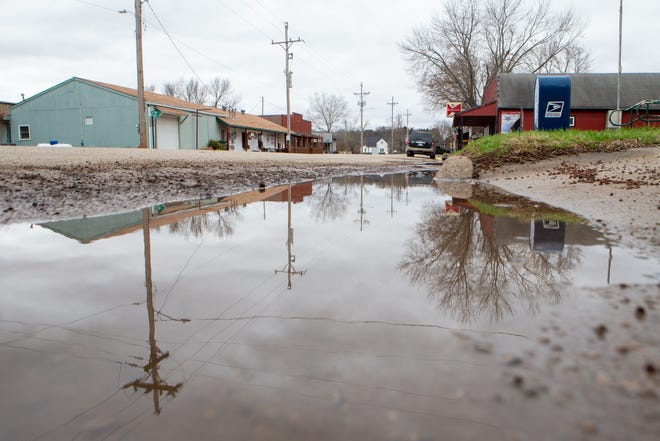U.S. News
How rural Kansas town Paxico looks to address its nitrate-ridden water and floodplain issues
Published
4 years agoon
By Matt Collins 
Editor

TOPEKA, Kan. – When it rains in the small, rural town of Paxico — which sits about 30 miles west of Topeka, just off Interstate 70 — pools of water remain long after each storm has passed.
“We have terrible stormwater runoff,” said resident Deanna Pierson. “We’re in a flood zone.”
Pierson, with help from an international organization that works with communities to address climate-related issues, published a survey late last year in The Wabaunsee County Signal-Enterprise to collect responses from area residents about local problems they thought needed to be addressed.
Nearly 75% of respondents, according to survey results provided to The Topeka Capital-Journal by Pierson, indicated reducing flood risk was a high priority.
But until recently, efforts to reduce such risk were stagnant — that is until Pierson connected with Thriving Earth Exchange, a program that aims to help communities of all sizes tackle local issues related to natural hazards and resources. And Paxico just so happens to be the smallest community with which the earth exchange has ever worked.
The Thriving Earth Exchange partnership is one of two different projects Paxico is undertaking to address water-related issues in the northeast Kansas town of about 280 people.
The other is an effort to connect the town to a rural water district in order to rid it of well water contaminated with nitrates, which recently led local officials to issue a drinking-water advisory for infants, pregnant women and nursing mothers.
“We’re getting up to the high end of (the Kansas Department of Health and Environment’s) limit for nitrates, so that sparked the conversation to look into other options,” said Ryan Theel, the utilities supervisor for Paxico.
Theel indicated the water-quality and floodplain issues have, in some ways, hindered progress in town. Fixing the nitrate problem will help residents, he said. And reducing the flood risk, he added, could improve local economic development.
Now, it’s a matter of seeing those projects through.
Project expected to address nitrate issue
Paxico City Council member Steve Tharman is the one spearheading the effort to connect to a rural water district.
He said the town first became aware of its high nitrate levels in late summer or early fall 2019 and began talking in September of that year about potential action.
Theel said there are a couple different reasons nitrates may end up in water systems.
“Farming industry nearby can be a cause, but it can also be naturally occurring in the groundwater,” Theel said. “The only way to know would be to do studies. It doesn’t really matter where it came from. It’s there, so now we’ve got to deal with it.”
Soon after becoming aware of the problem, Paxico officials connected with a supervisor at Wabaunsee Rural Water District No. 2, which encompasses the towns of Paxico, McFarland and Alma in northern Wabaunsee County.
“First, they had to look into their system to see if they had adequate quantity and pressure to serve a town of our size,” Tharman said. “When they got back that data, they said they could serve us enough water but not on a full-time daily basis.”
So Paxico agreed to pull water from the rural district between the hours of 10 p.m. and 6 a.m., when usage is low, providing the town 50 gallons of water per minute during that time frame, Tharman said.
“We have a water tower that holds around 70,000 gallons,” he added. “So we’ll just use that (to store the water) — and we’ll never use that much water during one day. We haven’t historically.”
Greg Dekat, assistant manager for the rural water district, has been working with Paxico to smooth out the details.
Dekat said the arrangement with Paxico will be the district’s first wholesale agreement, meaning the district won’t provide the water infrastructure it does for some clients.
“They have their own internal infrastructure, their own city pipes, their own storage tank,” Dekat said, “so they’re different than a retail customer who doesn’t have any infrastructure. … They have their own distribution, their own billing, so those things don’t get rolled up into the fees that we’ll charge them.”
Tharman said connecting to the water district is expected to cost Paxico about $305,000. That will cover the hookup — including installation of technology that allows the district to communicate with the town’s water tower — and the cost of constructing a building near the water tower to house parts of the new system.
“It’s basically a metering facility,” Dekat said. “It’s like a 12-by-15 building. It’s not anything grand. It’ll meter the water and also reduce the pressure on our system in Paxico.”
Paxico officials indicated they are working with a private landowner to build the structure near a corner of his property, and Tharman said the town’s attorney has drafted an agreement that should be reviewed at the city council’s next meeting.
Tharman and Theel each said they hope to be connected to rural water within the next six to eight months.
Funding raises concern
According to Tharman, Paxico is pursuing a loan from the Kansas Department of Health and Environment’s state revolving fund to pay for the project. He said the loan has a 20-year term and an interest rate of 1.3%.
“There’s a chance that the construction costs could come in lower — we don’t know. If they do, we won’t need the whole loan,” Tharman said. “But we are eligible for principal forgiveness on 30% of our loan. … On paper, we’re going to borrow $305,000, but money we’re borrowing and paying back is only $213,000.”
Still, the costs will mean rate increases for Paxico residents.
Tharman said they split the increase into two separate rate hikes to lessen the blow. The first increase was implemented in November, and the second will go into effect later this year.
Theel said the November hike increased the monthly minimum by about $10. It is unclear how much the next increase will be, as that will depend on final project costs.
Tharman said he is confident residents will be able to shoulder the hike. But Pierson, the resident who initiated the Thriving Earth Exchange partnership, said she is worried locals will struggle to make the higher payments.
She pointed to a median household income in Paxico of about $41,000, which is close to $20,000 lower than the state’s median household income, according to U.S. Census Bureau estimates.
“It’s not like I can’t absorb it, but there are a lot of people who don’t have what I have,” Pierson said. “I mean, drive around and look at some of these houses in the community.”
She suggested town officials look for grants, which don’t have to be paid back, to cover project costs.
Tharman argued pursuing grants isn’t as straightforward as it seems and indicated Paxico’s median household income is higher than the maximum allowed to apply for some grants that might have otherwise helped.
According to Theel, the cleaner water coming from the rural water district may lead to cost savings in other areas.
“If you get better-quality water, it will help your household plumbing and your water softener,” Theel said. “A lot of people have water softeners in town, but with this water, you won’t need water softeners. Your toilets and faucets and hot water heaters and stuff will handle this higher-quality water better, so there won’t be as much maintenance on those items.”
He said there is a good bit of local support for initiative.
“There’s a lot of people in town who are really wanting this and have been asking for this for a while,” he said.
Thriving Earth looking for solutions to flood problems
Paxico’s partnership with Thriving Earth Exchange, which has an international reach, is unique because of the town’s size.
According to Garrett Boudinot, an Earth and environmental scientist working with the program as a community science fellow, Thriving Earth Exchange likes to take a community-centered approach to addressing problems within municipalities.
“All of the projects are centered around some community priority that the community wants advanced or a community problem that the community wants solved,” Boudinot said. “Really our job is to identify how can Earth and environmental sciences help address that.”
So he said it was encouraging when Pierson reached out.
“There are so many small, rural communities in America, and the fact that we had a citizen of Paxico who reached out to us and was able to get this going was really exciting,” he said. “It’s a step in the right direction for reaching communities that could benefit from having these environmental-science connections.”
Boudinot worked with Pierson to survey area residents, and they determined there were a handful of issues — from infrastructure problems to flood risk — that the earth exchange could help address.
“It was no surprise to anyone that the flood risk was an issue,” Boudinot said. “Just about everyone I talked to in the area recognized it.”
But what could be done to fix it was the unknown factor.
Part of Boudinot’s job as lead fellow on the project is to connect with other scientists and experts, particularly those already based in Kansas, to study the problem further and offer the town potential solutions. Such analysis and advice comes at no cost to Paxico or its residents.
That study should take place over the next several months, and Boudinot expects to be able to offer recommendations to town officials by late summer or early fall. From there, it will be up to Paxico leaders to decide whether to act on such recommendations.
If Paxico does want to move forward with any of the suggestions, Boudinot said, Thriving Earth Exchange will help with that, too.
“If they say, ‘Yes, we love option A and B, and we don’t like options C, D and E,’ then the next step will be what can we do to help with that?” he said. “If it’s something that might still need a little bit of additional funding, we’re available to use the data we collected to put together a grant and acquire some of those funds.”
And helping Paxico secure funding for potential solutions could be crucial.
Theel doesn’t think it’s likely Paxico would be able to address its flood risks soon if it had to shoulder all of the costs.
Paxico Mayor Dan Wagner agreed.
“It’s a big issue for us. It’s an extensive issue and one that we’ve had for the whole history of our town,” he said. “As a small town with limited population, we have limited resources. So we need some outside help.”
Jim MacGregor, director of economic development for Wabaunsee County, said it is important for rural communities to build resiliency and create opportunities for both town residents and those looking to relocate to a rural area.
If tackling flood issues helps Paxico create opportunities, it could be a big deal for the town’s economic development, he said.
“For a business to get interested in Paxico and have to overcome the cost of insurance because a business might be in a flood plain, it could be a deterrent,” MacGregor said.
Theel suggested flood issues have stifled growth in the past.
“That is one thing that does slow people down when they come to look at Paxico for any kind of building or thing like that,” he said. “They find out there’s going to be more restrictions on how you build, how you do things. … If we can get some of these flood mitigation things figured out, that would help us.”




